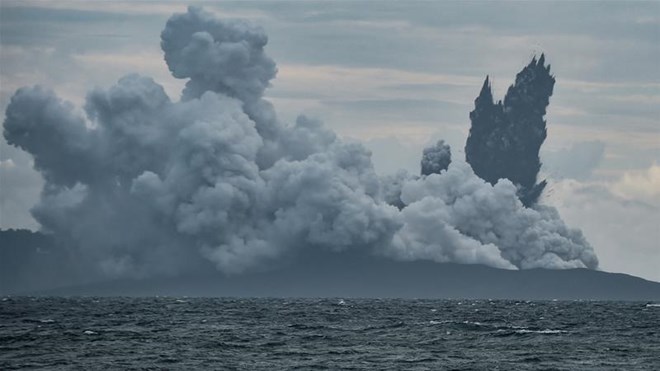Indonesian volcano Anak Krakatau loses two-thirds of height
Indonesia's Mt. Anak Krakatau, an active volcano whose eruption last weekend triggered a deadly tsunami, has lost over two-thirds of its height, according to the Centre for Volcanology and Geological Hazard Mitigation.
 |
| Scientists say the volcano now has a volume of 40-70 million cubic metres after losing 150-180 million cubic metres. (Source: Reuters) |
The centre said in a press statement on 29 December that the volcano now stands 110 meters high, down from 338 m in recent months.
According to the centre, which is based in the West Java provincial capital of Bandung, the position of Mt. Anak Krakatau's peak is now lower than the nearby islands of Sertung and Panjang.
The centre also said Mt. Anak Krakatau has lost between 150 million and 170 million cubic meters of its volume, with only between 40 million and 70 million cubic meters remaining.
"Anak Krakatoa is now much shorter, usually you can see the peak from the observatory post, now you can't," said Wawan Irawan, a senior official at the agency.
Before and after satellite images taken by Japan's space agency showed that a two square kilometre chunk of the volcanic island had collapsed into the water.
The eruption of the volcano on 22 December caused the southwestern flank of its caldera to collapse, causing underwater landslides that triggered a tsunami that hit nearby coastlines of Java and Sumatra.
A total of 431 people are confirmed to have died as of 29 December, with 15 others still missing and 7,202 injured. Nearly 47,000 people have been displaced.
Given the volcano's remaining low volume, the agency said the possibility of another tsunami being triggered by an eruption is low.
On 27 December, the centre raised the alert status of the volcano due to increased activity to Level 3, one notch below the highest level. It recommended that locals and tourists not be allowed within a radius of 5 kilometers of the peak.
Volcanic activity at Mt. Anak Krakatau has been on the increase since June, with almost daily eruptions.
It is the product of the infamous Krakatau, whose tsunami-triggering eruption in 1883 was one of the largest of modern times, killing more than 36,000 people and leaving a massive crater in which grew Mt. Anak Krakatau, or "Child of Krakatau."
(Source: VNA)